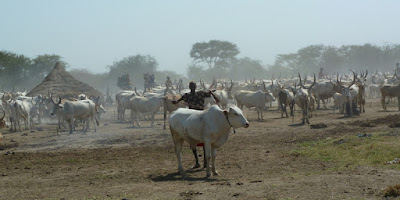An orange sun is slowly burning through the thick smoke filled haze on the horizon, lifting into the morning sky. A sweet pungent smoke fills my lungs as I’m jogging outside of R#mb#k in the early morning, a smoke from the cow dung fires in a cattle camp on the side of the road. Tall thin people, dark as night, are walking some carrying spears, some goods for market, others personal possessions. I continue jogging, absorbing the stares of curiosity, they must think this kawaja (foreigner) is really strange. A few months earlier, a female friend of mine had been jogging with a couple of Sudanese and she was running a bit behind them and the people they passed would comment in the local language which the Sudanese understood, “why is that kawaja woman chasing the men, what did she do that they are running away from her?”
The sun quickly burns through the haze and the cool crisp air (almost long sleeve weather) quickly evaporates and is replaced with a searing heat. Today I drive to M@per for a quick inspection of a project that is finally about to finish. As we depart from R%mbek, there are several large cattle camps along the road. There has been an extensive disarmament campaign going on, to disarm the cattle youth / warriors from their machine guns. They have collected a lot of guns, however many suspect that only the bad ones are given up and they are keeping the better ones. Most have more than one gun which are often buried underground or hidden around the villages. As the military is rounding up the guns, they may beat children or women until they confess as to where the guns are being hidden.
Now driving on the road, you don’t see a single AK-47, instead each warrior is carrying a hand full of spears. Several months ago, while on this same road, they were all carrying guns, slung across their backs or yielding them precariously at their sides. Later that day, I coincidentally come across one of the locations where the military is storing the guns before taking to town…they came that day to collect hundreds of semi automatic guns. There were at least 10 stacks of 10-20 guns in each stack which were loaded into a pickup sporting a large artillery gun mounted in the back. The guns looked in bad shape, dirty, covered in sand, dents, etc and I wondered if they could even fire. One military guy was trying to fix his own gun and one part wasn’t fitting properly and I saw a similar gun sitting in a pile so I said, just take that part and swap it. So he went ahead and harvested the spare parts to try and fix his gun. I probably shouldn’t get involved in a matter like that, but his struggling effort and lack of common sense in the matter was aggravating (when there are several different models of guns sitting there, and yours isn’t working, just find what you need and be done with it).
I met the general who was in charge and he was all smiles and allowed me to take pictures. (won’t post them on here).
As we drive past the first large cattle camp, I am amazed by the number of cows, as far as the eye can see, white bovine dot the landscape. It is an amazing site to behold. The dung smoke screening the cows, filling the air with a sweet dung smell, which is, oddly, not a terrible smell…very earthy. Small make shift shelter have been set up, sheets of plastic and fabric that will be their temporary home until moving on. On the return trip, the camps are eerily empty, all cows being herded into the bush for grazing.


Thousands of cows fill these camps and now with the dry season upon us, they will start looking for green pastures for their cows. This marks the start of the dry season cattle conflicts, as various tribes seek limited green grass and water sources for their cows, they will come in contact. Furthermore, with the movement of cattle and dry land for people to more readily move, warriors will attack and steal cows. Usually people are killed in the process and this leads to a cycle of revenge (blood for blood) and cattle raiding, as I’ve eluded to in earlier posts.
The M@per area and further north east enters the no man’s land, a swamp in the rainy season, a deadly cattle raiding zone during the dry season. An area where authorities fear to tread, where the warrior youth run the land. Also the area where several months ago I happened to drive through the middle of a cattle raid (see earlier post). It will be interesting to see how the conflicts unfold this dry season after the disarmament.
A youtube video (taken by someone else) of a dance at a cattle camp.










No comments:
Post a Comment